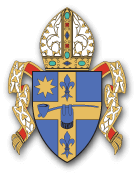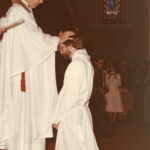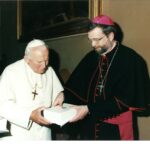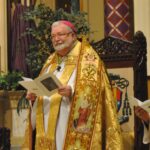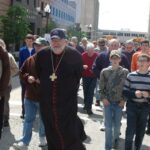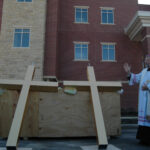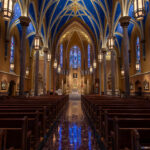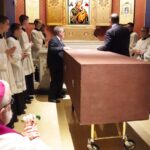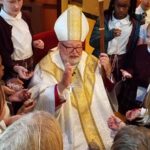Previous Bishops
Most Reverend Daniel R. Jenky, C.S.C.
Eighth Bishop of Peoria 2002-2022
He was born March 3, in 1947 in Chicago, Illinois. Attended St. Nicholas of Tolentine parish school on the south-west side of the city and St. Laurence High School, conducted by the Irish Christian Brothers. In 1966, after a year at the University of Notre Dame, he entered the novitiate of the Holy Cross Congregation in Vermont. Following his First Profession in 1967, he was assigned to Moreau Seminary to continue his education at Notre Dame. In 1970, he earned a bachelor’s degree in history, and in 1973, he completed graduate studies in theology. The same year he professed his final vows and was ordained a deacon. He served at Sacred Heart Parish and assisted the residential staff of Flanner Hall.
In 1974, he was ordained a priest and taught Social Studies and Religion at Bourgade Catholic High School in Phoenix, Arizona.
After a year, he returned to Notre Dame and was appointed Rector of Dillon Hall and Associate Director of Campus Ministry. He became rector of Sacred Heart Church and later Director of Campus Ministry. He held this position for only one year, when he was named Superior of the local Holy Cross community and Rector of Fischer O’Hara Grace, a residential complex for 560 graduate students. While still the Rector of Sacred Heart, in 1992 the church was raised to the rank of a Minor Basilica, nationally renowned for its rich liturgical tradition. During the years when he was the Rector, he organized liturgies for all major university occasions and special events and coordinated the six choirs connected with Campus Ministry. He also regularly taught course on spirituality and theology of prayer in Notre Dame’s graduate school.
In October of 1997, Pope John Paul II appointed him as Auxiliary Bishop of Fort Wayne-South Bend and titular Bishop of Amantia. He was ordained at St. Matthew Cathedral in South Bend, Indiana, on December 16. John D’Arcy, Bishop of Fort Wayne-South Bend, appointed Bishop Jenky as Rector of the Co-Cathedral and Pastor of the parish.
On February 12, 2002, on the day of the 127th anniversary of the establishment of the Peoria Diocese, Pope John Paul II appointed him the eighth Bishop of Peoria. He was installed on April 10, 2002, in the Cathedral of Saint Mary of the Immaculate Conception in Peoria.
In two months, he petitioned the Vatican to open the cause for canonization of Archbishop Fulton J. Sheen.
Each year, he issued a Festival Letter teaching on various subjects of the Catholic faith.
In 2003, in a passionate homily he called the men of the diocese to “rise up and stand with our God” in the midst of a culture that “is at war with Jesus Christ.” This led to a popular annual Men’s March.
In 2004, Bishop Jenky appointed Patricia M. Gibson the first lay chancellor in the history of the diocese.
In 2008, he blessed the newly built Spalding Pastoral Center, which houses all diocesan offices, large conference center as well as the Fulton Sheen Museum.
A firm advocate of Catholic healthcare, in 2010, he dedicated the OSF Milestone Building in Peoria and fought for the legacy of Catholic Charities against the clashing state laws.
In 2016, his dream of restoration of St. Mary Cathedral came true, bringing back its beauty and longstanding tradition.
On June 27, 2019, he welcomed the remains of Venerable Archbishop Fulton J. Sheen to be reinterred in St. Mary Cathedral, Fulton Sheen’s home parish.
Soon, with great disappointment, he announced an unexpected postponement of Sheen’s December 19 beatification, which deeply saddened the Church.
In the middle of the COVID-19 pandemic, that caused closure of schools and churches, Bishop Jenky welcomed the newly-ordained coadjutor bishop Louis Tylka to succeed him as the Bishop of Peoria.
Throughout his tenure, Bishop Jenky traveled widely around the twenty-six counties of the Diocese visiting parishes and schools and conferring the Sacrament of Confirmation. He promoted priestly vocations, enriched presence of religious communities in the diocese and was a strong supporter of the Catholic schools.
In March 2022, after 20 years of being the Chief Shepherd of Peoria Diocese, Bishop Jenky retired.
Most Reverend John J. Myers, D.D., J.C.D.
Seventh Bishop of Peoria 1990-2001
Coadjutor Bishop 1987-1990
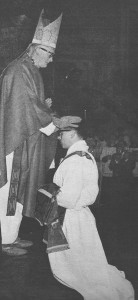
John Myers' priestly ordination in Rome
Second native son to held the office. Born July 26, 1941, in Ottawa, as the eldest of seven children and raised on a farm near Earlville in LaSalle County
Ordained December 17, 1966, in St. Peter's Basilica in Rome.
He was not convinced of his vocation to the priesthood until the end of his freshman year at Loras College in Dubuque, Iowa. "God kept asking me" to be a priest, he told Emmaus Days retreatants in 1995, "but I didn't pay a lot of attention at first." He switched to the college's seminary program in his sophomore year, graduated in 1963 and completed studies for the priesthood at the North American College in Rome.
After his first assignment at Holy Family Parish in Peoria, he then worked in the international affairs office of the U.S. Catholic Conference before returning to the diocese in 1971 to serve as an assistant at St. Matthew Parish in Champaign.
In 1977 he earned his degree in canon law at the Catholic University of America and Bishop O'Rourke appointed him vice chancellor and vocation director. At that time, he launched the highly popular Emmaus Days vocation awareness retreats for young men.
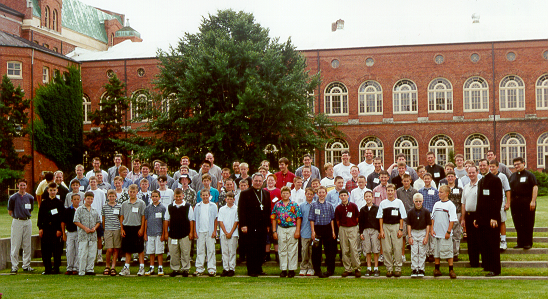
Emmaus Days 2000
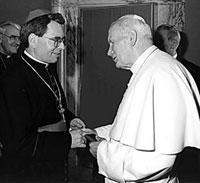
Bishop John J. Myers and Pope John Paul II
On September 3, 1987, he was made a Coadjutor Bishop to assist Bishop O'Rourke and succeeded him as governing Bishop when he retired in 1990.
Five months later, Bishop Myers released his first and most highly publicized pastoral message "The Obligations of Catholics and the Rights of Unborn Children" which drew national media attention for stating that "there is, and can be, no such thing as an authentic 'pro-choice' Catholic."
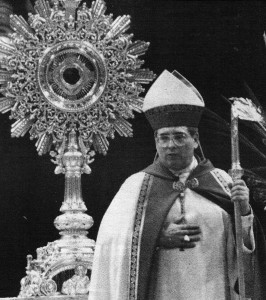
The Eucharist: Sacrifice of Love - Pastoral Letter
His next pastoral letter "The Eucharist: Sacrifice of Love" announced plans for a Diocesan Eucharistic Congress in 1992, to be preceded by a year of special attention and devotion to the Eucharist. Later pastoral letters included topics on Catholic education, family, chastity education, fatherhood and on the life of senior priests.
Bishop Myers ordained more than 80 new diocesan priests in his 11 1/2 years as bishop. In some years the Peoria diocese ordained as many or more priests than far larger sees such as New York, Chicago and Los Angeles, again gaining nation attention for bucking the long-standing trend of declining vocations.
In 1998 he announced the creation of the diocese's first new Catholic high school in 35 years named after St. Thomas More in Champaign, which opened in the fall of 2000.
He invited several new religious orders into the diocese, including Bl. Mother Teresa's Missionaries of Charity, the Community of St. John, the Sisters of St. Francis of the Martyr St. George (Alton Franciscans), the Rockford Poor Clares. With then-Bishop Charles Chaput of Rapid City, S.D., he formed a "sister diocese" relationship between the dioceses of Peoria and Rapid City.
On July 24, 2001, Bishop Myers was called to succeed Cardinal Theodore E. McCarrick as the Archbishop of Newark in the seventh largest archdiocese in the United States.
In 2005, Pope Benedict XVI named Archbishop Myers the Ecclesiastical Delegate for admitting married former Anglican clergy in the United States to the Catholic priesthood. He held this post until 2011.
Some major points of Archbishop Myers’ Newark tenure:
- 150th anniversary of the Archdiocese of Newark
- Studies on the future of the parishes and schools
- Raising awareness in New Jersey and nationally to the sin of human trafficking
- Addressing important public issues as the abolition of the death penalty, affordable housing, poverty, and charity care.
Reaching the age of 75 years, and upon the installation of Cardinal Joseph W. Tobin, C.Ss.R., the succeeding Archbishop of Newark on January 6, 2017, Archbishop Myers was granted the title Archbishop Emeritus of Newark.
On Thursday morning of September 24, 2020, shortly after returning to his native Illinois, Archbishop John J. Myers entered into eternal life. At the request of his family, the funeral took place at St. Mary Cathedral in Peoria and the Archbishop was buried in the Bishops’ Mausoleum at St. Mary Cemetery in Peoria.
Most Reverend Edward W. O'Rourke, D.D.
Sixth Bishop of Peoria 1971-1990
First native son to hold the office of Bishop of his diocese. Born October 31, 1917, on his family's farm near Downs. One of eleven children of Martin and Mary Hickey O'Rourke, founding members of St. Mary Parish in Downs.
Ordained May 28, 1944, by Bishop Schlarman in St. Mary Cathedral in Peoria.
At the age of 13, on the night of his confirmation in 1930, he became convinced of his vocation to the priesthood, and for the rest of his life "never had a moment of doubt that this was my calling."
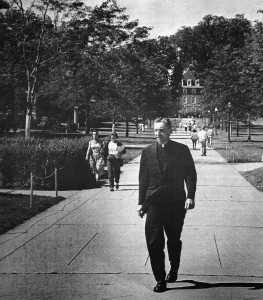
Newman Foundation at the University of Illinois in Champaign
Fr. O’Rourke surely did not know that his first assignment of assistant chaplain at the Newman Foundation at the University of Illinois in Champaign would last sixteen years.
From 1948 to 1955 he also served as diocesan director of resettlement for displaced persons fleeing the communist takeover of Eastern Europe, finding homes and jobs for hundreds of such refugees.
In June 1960 he was named executive director of the National Catholic Rural Life Conference. For the next eleven years he helped establish hundreds of economic development committees, cooperatives and other self-help programs in the U.S. and abroad. He lectured widely on his experiences in developing countries, traveling more than 140,000 miles to nineteen nations in one year alone.
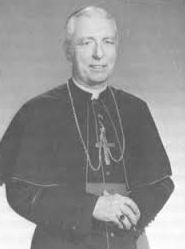
Installation as Sixth Bishop of Peoria
On June 1, 1971, he was named bishop of Peoria to succeed the retiring Bishop John B. Franz. At his installation Mass on July 15, he set the tone of his episcopacy by challenging himself and his flock to "extend comfort to all who are lonely, broken-hearted or in pain ... strive to reconcile those who are alienated and restore economic dignity and security to those who are poor." He was known as a champion of rural life, social justice and simple living.
Several months later, he demonstrated his commitment by selling the Bishop's Mansion on Glen Oak Avenue, moving into a one-bedroom brick ranch near St. Mary Cathedral, and depositing the money from the sale into the retired priests’ fund. He received national attention also as an advocate of simple living following an editorial he wrote on the subject for The Catholic Post in 1974.
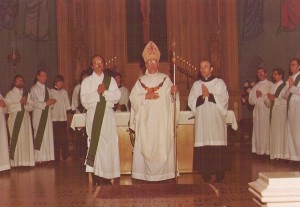
First Diocesan Class Ordination of Permanent Deacons
Bishop O’Rourke reorganized the diocese into 15 vicariates, replacing the old system of six deaneries. He ordained the diocese's first class of permanent deacons in 1976 and launched the Teens Encounter Christ program and retreats for widowed and divorced.
He made international headlines in 1976 when he was aboard a New York to Chicago TWA flight hijacked and diverted to Paris by Croatian nationalists. He led the passengers in prayer and tried to persuade the hijackers to give themselves up during the 32-hour ordeal, which ended with the hijackers surrendering to French police.
In 1986, he established the Annual Stewardship Appeal (now know as the Annual Diocesan Appeal) and a diocese-wide policy for marriage preparation that remains in effect, with some modifications, to this day.
In his 1993 pastoral letter "Jesus the Divine Teacher" he proposed five new mysteries of the rosary focusing on Christ's public life. Eventually, three of these appeared in the new Luminous Mysteries of Pope St. John Paul II.
Despite a number of health problems, he maintained a large garden and gave away produce he couldn't use to his neighbors, friends and the needy.
In 1987 Father John J. Myers, his Vicar General, was appointed coadjutor bishop with right of succession. After Bishop O'Rourke announced his retirement in January 1990, Bishop Myers succeeded him as Ordinary, and Bishop O'Rourke moved to the St. Augustine Manor retirement residence in Peoria.
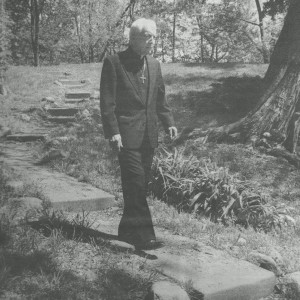
Bishop O'Rourke Retirement
A few months later, Bishop O'Rourke founded Renaissance Stand, an organization designed to help the long-term unemployed obtain jobs and job training. He devoted much of his days to the volunteer organization's work. "I've been all over the world," he said in 1996, six years after his retirement and 25 years after becoming bishop. "But now I will concentrate on this one section of Peoria where I live and make it my responsibility." He continued to tend his vegetable garden until failing health forced him to give up such activity.
Following his death on September 29, 1999, at age 81, his funeral drew thousands to St. Mary Cathedral, including those he had helped find jobs, homes or other assistance. He was buried in the Bishop's Mausoleum at St. Mary Cemetery in Peoria. His tomb is inscribed with the epitaph "Friend of the Poor”.
Most Reverend John Baptist Franz, D.D.
Fifth Bishop of the Diocese of Peoria 1959-1970
Born October 29, 1896, in Springfield, IL, the youngest of seven children
Studied at St. Francis in Quincy and Kenrick Seminary in St. Louis
Ordained June 13, 1920, by Archbishop John Glennon in Kenrick Chapel
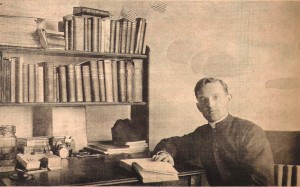
Kenrick Seminary
He recalls that his parents "provided us an atmosphere that made us conscious we were Catholic and that we belonged to the Church. I never wanted to be anything but a priest.” His studies took him to St. Francis Solanus High School in Quincy, then to its Franciscan College Department and to Kenrick Seminary, where he completed his work and was ordained by Archbishop John J. Glennon on June 13, 1920.
He became a member of the Springfield Diocese Mission Band, traveling through Illinois and Missouri giving missions and retreats until 1926, when he was appointed to lead a campaign fund for a cathedral complex in Springfield. The drive was a smashing success, and Father Franz himself was appointed rector of the Cathedral.
On the Feast of Beheading of John the Baptist, his patron Saint, August 29, 1951, Msgr. Franz was consecrated a bishop of the new see of Dodge City, Kansas. Bishop Schlarman of Peoria preached the sermon.
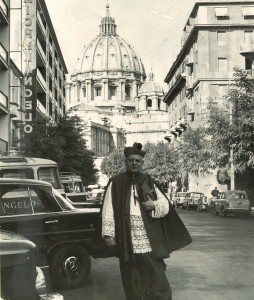
Bishop Franz - Second Vatican Council in Rome
Just eight years later, he was appointed to the Diocese of Peoria where he was installed November 4, 1959. His tenure was to bridge the tumultuous years before, during, and after the Second Vatican Council. He stated that participation at the Council was the high point of his life. He studied every draft document and knew the contents of each thoroughly. Proud of his diocese, he wrote in his letter from Rome, “one cannot but be impressed by the vigorous lay apostolate that is developing in our diocese, a development that conforms admirably to the proposed schema on De Laicis.”
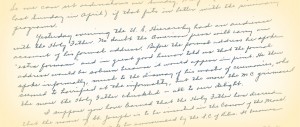
Vatican Letter
Similarly, reporting the events of Vatican II in 1964, The Register noted, “Peoria can take great pride in the fact that the actions of our third bishop in 1934 are now being ‘widely imitated’ by the universal Church, actions which the fifth bishop of the diocese, John Baptist Franz, ‘A MUST’ for the Diocese of Peoria.”
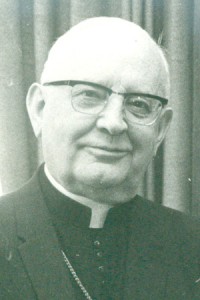
Bishop Franz Post-Conciliar days
Returning back to the Diocese, he promptly implemented the council decisions with all the background information that the Holy See provided for each directive, such as extending the use of the vernacular, introduction of concelebrated Masses, new rites for marriages and funerals. With a steady hand and enormous common sense, he kept the Diocese of Peoria from experiencing many of the unnecessary upheavals that other dioceses experienced during the Post-Conciliar days.
His years were to see the construction of seventeen new grade schools, two new high schools, one Newman center, four new parishes, four missions and the raising of eight missions to parish status. He also presided over the Fifth Synod of the Diocese, modernizing and codifying regulations and rights of the diocese.
Bishop Franz died at the age of 95 on July 3, 1992, at St. Joseph Home in West Peoria and was buried in St. Mary Cemetery.
Most Reverend William E. Cousins, D.D.
Fourth Bishop of Peoria 1952-1958
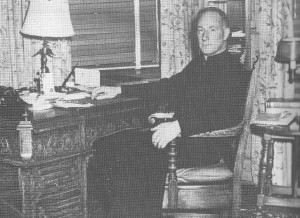
Cousins
Born August 20, 1902, in Chicago
One of the first priests ordained from the newly opened St. Mary-of-the-Lake Seminary in Mundelein on April 27, 1927
Member of an English-Polish mission band at the request of Cardinal Mundelein for 12 years
Fr. William E. Cousins was named Auxiliary Bishop of Chicago on December 17, 1948, and four years later appointed to the Peoria Diocese. The Chicago New World expressed the sentiments of many, saying, “Our loss, and it’s really a loss, is Peoria’s gain.” Cardinal Stritch presided at his installation at St. Mary Cathedral o July 2, 1952, laying before him the challenge of his illustrious predecessors.
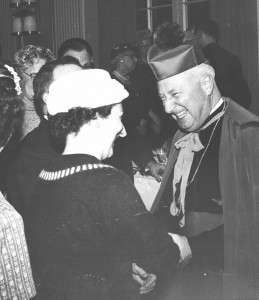
Cousins - outgoing personality and congenial personality
The post-World War II years brought expansion of the Church in America and demanded expansion of the church and school facilities as well. Bishop Cousins preferred informal and personal contact with people rather than from behind his desk. His general manner was one of kindness, compassion, patience and deep respect he had for others. He was a man of outgoing spirit and genial personality.
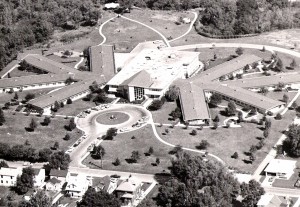
St. Joseph Home, Peoria
Among his recorded accomplishments is the establishment of five new parishes and six new grade schools and the construction of the new $2,000,000 St. Joseph Home in Peoria, considered one of the best retirement homes in the country.
His charisma with laymen and women was notable and led to his success with lay organizations of which he was a great promoter. The success of the Diocesan Council of Catholic Women prompted Bishop Cousins to establish the Diocesan Council of Catholic men which was at once met with positive response. More than four thousand men attended the opening convention in Peoria in 1956.
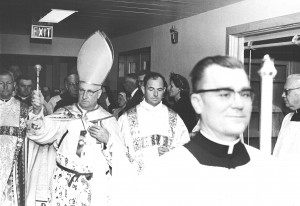
Diocesan Council of Catholic Men
After six years spent in Peoria, Bishop Cousins received another appointment and left to lead the flock of the Archdiocese of Milwaukee. Upon his leaving by a special train, a contingent of Peoria priests accompanied him to his new post, a tribute to a friend and leader the diocese had learned to love and respect.
He died on September 14, 1988, at the age of 86.
Most Reverend Joseph H. L. Schlarman
Third Bishop of Peoria 1930-1951
Born February 23, 1879, in Breese Township in Southern Illinois, tenth child of a German family
Noted historian and liturgist of nationwide measure
Named titular Archbishop a few months before his death in 1951
Ordained June 29, 1904, in Cathedral in Brixen, Tyrol
The future bishop received his early training at the hands of Sisters known as the Poor Handmaids of Christ, and also under the direction of his own brother Henry, who was schoolmaster and organist as St. Boniface Parish in Germantown.
After four years at St. Francis Solanus College in Quincy, studying initially medicine, he changed his mind and decided to study theology. There he also became a Franciscan Tertiary: “The Franciscan Fathers lassoed me shortly after my entering Quincy College.” His courses took him to Innsbruck and Rome as well. Later he was named chancellor at the Cathedral of Belleville, his home diocese.
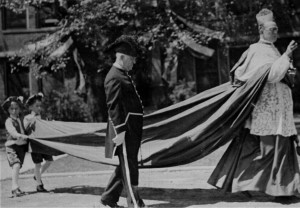
Consecration of Joseph H. L. Schlarman as Third Bishop of Peoria
On June 17, 1930, he was consecrated the Third Bishop of Peoria in the cathedral at Belleville by Cardinal George Mundelein, Archbishop of Chicago.
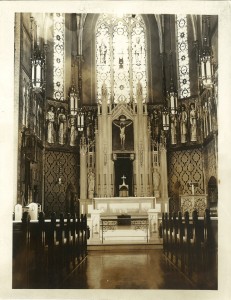
Cathedral of St. Mary of the Immaculate Concepetion
Despite poor health (he survived fifteen operations and received the Last Sacraments six times), he served the diocese with unusual fervor. Under his guidance, the diocese became better organized and financially secure. Governor Horner appointed Bishop Schlarman a chairman of a commission for the study of prison problems which culminated in his deeply analytic book Why Prisons? He was also actively involved in the National Catholic Rural Life Conference.
In 1934, he launched a largest renovation of St. Mary Cathedral, which, due to the depression years, turned out to be a ten-year-long, but probably his most beloved project called “Redemption”, followed in the smallest details. In it he combined his great love for the Church, liturgy and beauty, along with his desire to teach his flock to appreciate and utilize them in their own life of faith. All his undertakings in the cathedral were explained step by step in the The Peoria Register (later The Catholic Post) which he established in 1934.
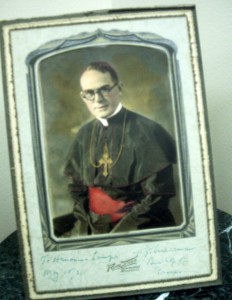
Bishop Joseph H. L. Schlarman
A man much ahead of his own time, he tried his best to institute in people love for the liturgy and understanding for the Divine worship. He was one of the few bishops in the United States who were stressing the need of participation at the liturgy by the people, its scripture roots, centrality of the Mass and Sacraments, lay movements, role of music and art in the liturgy. All of these efforts, pioneered by Bishop Schlarman in his time, were re-introduced and implemented during Vatican II.
Among his extra-diocesan activities was promotion of the Montezuma seminary near Las Vegas, which Bishop Schlarman supported and encouraged wholeheartedly. In the footsteps of his predecessors, he was very much interested in the Catholic education. In late 1930’s he started the renowned and successful Peoria-Aledo Plan for catechizing children in rural areas.
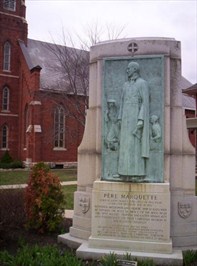
Fr. Marquette Memorial, Utica
Just a few months before his arrival in Peoria, he had published his best-seller “From Quebec to New Orleans-Story of the French in America” in which he displays his full admiration for the Christian missionaries in the country, particularly Fr. Marquette. In 1951, he thoroughly enjoyed a long-planned glorious celebration of Fr. Marquette’s 300th anniversary in Utica. This personal hero of his was there at the end of his life as well, when only a month later, on November 10, 1951, Bishop Schlarman died suddenly before a morning Mass in his residence.

Funeral Mass - Bishop Schlarman
After one last time in his beloved cathedral, Bishop Schlarman, “falling like a mighty oak”, was buried in the Bishops’ mausoleum at St. Mary Cemetery.
Most Reverend Edmund M. Dunne
Second Bishop of Peoria 1909-1929
Born February 2, 1864, in Chicago, into an Irish family that traced its history back to the 12th century
By special permission admitted to the priesthood studies at an early age of 17
Distinguished student speaking Latin, German, Italian, Polish and modern Greek almost as fluently as English, with reading knowledge of several other languages
Played organ, piano, violin and loved to sing
June 24, 1887, ordained to priesthood at St. Quintin Church in Louvain, Belgium,
In the summer of 1909, the chancellor of the Chicago Archdiocese was appointed the Second Bishop of Peoria, being consecrated September 21, in St. Mary Cathedral. There were those who said, "I could have told you so."
He recalls the day of his installation in Peoria:
…A flood of telegrams and letters came pouring in from priests and people of the Peoria diocese assuring me of their sincere welcome, profound esteem and hearty cooperation. The little messenger boy from the local telegraph office near my home could not comprehend it. After trudging back and forth one day at least a dozen times with messages of greeting and congratulations, he finally summoned up courage to ask what it all meant.
“What's going on here,” he inquired, “a wedding?”
“Yes,” replied my mother. “My son is going to be wedded to the Diocese of Peoria!”
His ten-year experience of working with Italian immigrants at the Holy Guardian Angel Church in Chicago prepared him for the new task. Just two months after his arrival in Peoria, the newly-appointed Bishop personally visited the scene of the Cherry Mine disaster doing what he could to comfort the families of the victims. He arranged for care for the widows and orphans at St. Bede’s and St. Mary’s orphanage in Metamora. He also organized the collection of more than $8,000 for their support and invited Sisters who spoke various languages to assist the surviving families in whatever ways possible.'
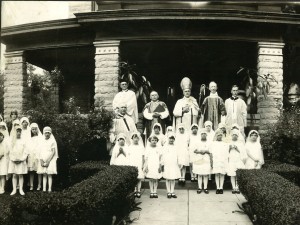
First Holy Communion

Bishop Dunne with friends
He was an enthusiastic supporter of Pope Pius X’s decree on children’s age for First Holy Communion. “Away then with all fear of their childish levity and lack of reverence,” he said. “Their tender minds and hearts are ready. Let us not be more solicitous about the interests of God’s glory than He Himself.”
The first impressions of Bishop Dunne never required revision. He was a man of full information, poised in judgment, charitable toward the rich as well as the poor, tolerant, sympathetic and modest. He loved the common people and his supposed sternness was just a shield of his sensitive tenderness. The grip of his hand was not a perfunctory clasp, it was genuine. He wore his heart upon his sleeve.
Independently rich in his own name, he never took a penny from the Catholic Church during the score of years he served as Bishop, and many a person and institution – unknown to the world at large – was aided from his private fortune.
He loved clean, outdoor sports; in his younger days he was an athlete. He was a devout churchman, good citizen and a patriot. He loved his fellowmen in his church and out of it. He loved his flag and what it stands for. Among all classes he was held in high esteem.
In 1914, Bishop Dunne purchased Oesterles’ Grove, a popular picnic ground in West Peoria, where a modern, three-story fire-proof orphanage for 200 children was to be built. On August 15, 1914, St. Mary’s Orphanage from Metamora moved here and with the location it changed the name to Guardian Angel Home. It is attributed to Bishop’s fond memories of his Chicago Italian parish, Guardian Angel. Bishop put the Sisters of St. Francis of the Immaculate Conception in charge of the new home which was dedicated on Thanksgiving Day, November 26, 1914.
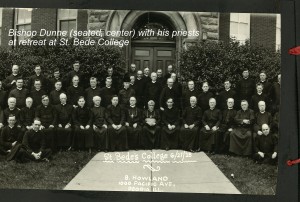
Clergy Conference (Retreat)
In 1917, at the prompting of the Holy See, Bishop Dunne inaugurated Clergy Conferences dealing with theology, discipline, liturgy, morals and scripture.
Bishop Dunne’s interest in Catholic education was as lively as his predecessor’s. Testimony to this was a memorable occasion in 1913, when he dedicated three new Catholic schools in Ottawa – St. Francis, St. Columba and St. Patrick. Another compliment to the Bishop’s educational efforts was his encouragement of the Newman Centers for the college students, beginning with University of Illinois in Champaign.
Bishop Dunne died on October 17, 1929, at St. Francis Hospital in Peoria, and was buried with great ceremony from the Cathedral on October 22, 1929, at St. Mary Cemetery.
Most Reverend John Lancaster Spalding
First Bishop of the Diocese of Peoria 1877-1908
Born in Lebanon, Kentucky, June 2, 1840, as the eldest of nine children and tutored by his well educated mother
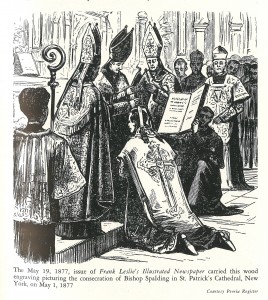
Consecration - May 1, 1877
Ordained December 19, 1863, in Louvain, Belgium, at the age of 23
Consecrated Bishop by Cardinal James Gibbons on May 1, 1877, at St. Patrick Cathedral, New York, just three weeks short of his thirty-seventh birthday
“…The day that John Lancaster Spalding came to Peoria was a city holiday. Businesses closed for the occasion and nearly the whole town turned out to greet him as he arrived in late afternoon at the railroad station and given a king's welcome. A special committee had journeyed to Bureau Junction to escort the bishop into his see city, and crowds waited to give him a military salute.
Upon his arrival, the bishop was placed in a carriage, a band played and hundreds lined the route from the station to his stopping points. At his first he was scheduled to talk in a hall with a capacity of 5,000, but the crowd was so large it overflowed into the street, so he spoke from the steps for best advantage. From there the entourage continued to St. Mary's Church and rectory, then located on Jefferson Street, where additional crowds waited in front of the rectory.
He was formally installed by Bishop Thomas Foley of Chicago in St. Mary's Church on May 22, 1877.”
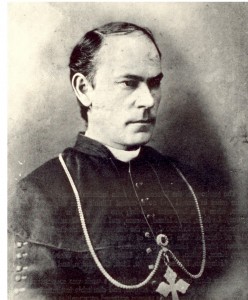
Bishop John Lancaster Spalding - Age 38
For the next thirty-one years, Bishop Spalding headed the Peoria diocese with style and verve, enhancing his reputation as an orator and supporter of Catholic education. Already in 1871, following the example of his uncle, Bishop Martin Spalding, he was tirelessly campaigning for the establishment of the Catholic university of America which culminated in its opening in November 1889.
Cardinal Gibbons noted that "…all great works have their inception in the brain of some great thinker. God gave such a brain, such a man, in Bishop Spalding. … If the Catholic University is today an accomplished fact, we are indebted for its existence in our generation, in no small measure, to the persuasive eloquence and convincing arguments of the Bishop of Peoria.”
Almost twenty years after having been the youngest member of the Second Council and named one of the preachers at the age of 26, he also attended the Third Plenary Council of Baltimore in 1884. He was personally involved in the development of the Baltimore catechism. Later, as a president of the Catholic Educational Exhibit at the 1893 World’s Columbian Exposition in Chicago, he took this opportunity to highlight and emphasize the importance and role of the Catholic schools.
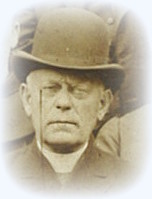
Bishop John Lancaster Spalding - Age 63
Bishop Spalding openly appreciated and supported establishment ethnic parishes of every nationality. He defended their enrichment for the country and diocese in the distinct cultural and religious heritage of each nationality.
In 1902 President Theodore Roosevelt appointed Bishop Spalding a successful mediator in the anthracite miners’ strike.
Due to a debilitating stroke in 1905, three years later Bishop Spalding resigned his position. He was named titular Archbishop of Scytopolis. During his life he authored numerous volumes, among them the biography of his uncle, Archbishop Martin Spalding of Baltimore, and titles such as "Essays and Reviews", "Lectures and Discourses", and "Education and the Higher Life". Under the name of Henry Hamilton, he wrote a book of poetry, "The Poet's Praise" and "Opportunity and Other Essays".
After his death on August 25, 1916, Pope St. Pius X said of him a rare praise, "Few bishops had so great an influence on the life of the people, even outside of religion and outside of the Catholic denomination, as had Bishop Spalding."
